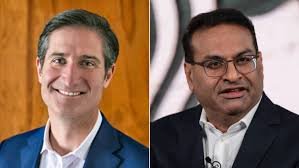
In a stunning turn of events, Starbucks has dismissed its Indian-origin CEO, Laxman Narasimhan, just 18 months after he took the helm of the coffee empire.
On Tuesday, Starbucks parted ways with Narasimhan as he stepped down as the chief executive and as a member of the Starbucks board “with immediate effect,” said the company in a statement.
The statement further added that the Seattle-based coffee giant will be run by Brian Nicco, CEO of Chipotle, an international fast food chain brand, from September 9, with Starbucks chief financial officer (CFO) Rachel Ruggeri serving as interim CEO until then. Whereas, Mellody Hobson, Starbucks board chair, will become the lead independent director.
After news of Starbucks CEO stepping down broke, the markets have responded positively to the changes at the top as the company’s shares increased on S&P 500 by 24 per cent to hit their biggest intraday gain on record, adding over $20 billion in market capitalisation.
Meanwhile, Narasimhan’s abrupt exit has sparked discussions on social media platforms about what went wrong with the Indian-origin CEO and what his ouster means for Starbucks. Here’s a closer look
**
Who is Laxman Narasimhan?**
Laxman Narasimhan, a 57-year-old from Pune, Maharashtra, began his career at McKinsey & Company in 1993 as a Director. After a 12-year stint with the
Narasimhan’s impressive track record led him to Starbucks in March 2023, where he was tasked with spearheading a major “reinvention” of the coffee leader. His appointment followed a period of collaboration with former Starbucks CEO and interim leader Howard Schultz.
Starbucks said in its statement that the outgoing CEO, during his tenure, “improved the Starbucks partner experience, drove significant innovation in brand’s supply chain, and enhanced our store operations.”
Narasimhan holds an engineering degree from the College of Engineering, Pune, an MA in International Studies from The Lauder Institute at the University of Pennsylvania, and an MBA in Finance from The Wharton School at the University of Pennsylvania.
What’s behind Narasimhan’s ouster?
Starbucks has not disclosed specific reasons for Laxman Narasimhan’s departure, but speculation points to several factors. Reports suggest that the CEO’s exit was driven by the company’s underwhelming global performance and recent controversies during his tenure.
Just before the CEO change, Starbucks shares had dropped 20 percent this year, and the company experienced two consecutive quarters of declining comparable sales. The coffee giant also faced backlash related to the Israel-Palestine conflict last year, when Starbucks Workers United posted “Solidarity with Palestine” on social media platform X shortly after a Hamas attack on Israel, leading to protests and calls for boycotts in the US.
